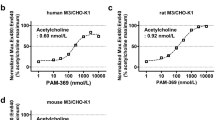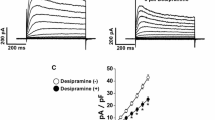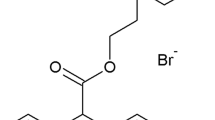Summary
A selective antagonist for the recently characterized 5-HT4-receptor is lacking. The only surmountable antagonist available, ICS 205-930, is a weak antagonist and is far more potent at 5-HT3-than at 5-HT4 receptors. In this paper, SDZ 205-557 (2-methoxy-4-amino-5-chloro-benzoic acid 2-(diethylamino) ethyl ester) is characterized as the first potent, selective and surmountable antagonist at 5-HT4 receptors in the isolated guinea pig ileum.
SDZ 205-557 was investigated in the non-stimulated and in the field-stimulated guinea pig ileum longitudinal muscle preparation for its affinity for 5-HT4-, 5-HT3-, muscarine-, nicotine- and histamine H1 receptors. The affinity for 5-HT1-, 5-HT2-, α1-, α2- and opiate (μ) receptors was determined by binding assays. SDZ 205-557 was devoid of substantial affinity (pKD values below 5.6) for all receptors investigated except for 5-HT3- and 5-HT4 receptors. At these two receptors, SDZ 205-557 acted as an antagonist without measurable intrinsic activity.
At the 5-HT4 receptors of the non-stimulated guinea pig ileum, responses to 5-HT and 5-methoxytryptamine were antagonized by SDZ 205-557 with identical pA2 values of 7.4. The effect of renzapride was also blocked with no significant change in the maximum response; Schild analysis, however, revealed that the interaction was not competitive with an “apparent” pA2 value of 7.6. A pA2 of 6.8 was obtained using zacopride as a contractile agent; this value differed significantly from 7.4, the value obtained for 5-HT and 5-methoxytryptamine. The effects of metoclopramide were inhibited non-competitively with a pD2' value of 5.4. 5-HT4 receptor mediated effects in the field-stimulated guinea pig ileum were antagonized in a similar way by SDZ 205-557. The resulting pA2 values were not significantly different from those obtained in the non-stimulated preparation.
In the non-stimulated preparation, contractions induced by 5-HT and 2-methyl-5-HT via activation of 5-HT3 receptors were antagonized by SDZ 205-557 only at concentrations of 10−6 mol/l and above yielding pA2 values of 5.6 and 5.9, respectively, which were considerably lower than those obtained for the blockade of 5-HT4 receptors. At concentrations greater than 10−6 mol/l, SDZ 205-557 caused a significant reduction of the maximum responses, indicating non-competitive antagonism.
It is concluded that SDZ 205-557 is a potent, selective and surmountable antagonist at 5-HT4 receptors in the isolated guinea pig ileum, and is a more practical tool for the characterization of 5-HT4 receptors than ICS 205-930.
Similar content being viewed by others
References
Arunlakshana O, Schild HO (1959) Some quantitative uses of drug antagonists. Br J Pharmacol Chemother 14:48–58
Barnes JM, Barnes NM, Costall B, Domeney AM, Johnson DN, Kelly ME, Munson HR, Naylor RJ, Young R (1990) The differential activities of R(+)- and S(−)-zacopride as 5-HT3 receptor antagonists. Pharmacol Biochem Behav 37:712–727
Bradley PB, Engel G, Feniuk W, Fozard JR, Humphrey PPA, Middlemiss DN, Mylecharane EJ, Richardson BP, Saxena PR (1986) Proposals for the classification and nomenclature of functional receptors for 5-hydroxytryptamine. Neuropharmacology 25:563–576
Buchheit K-H, Engel G, Mutschler E, Richardson B (1985) Study of the contractile effect of 5-hydroxytryptamine (5-HT) in the isolated longitudinal muscle strip form guinea-pig ileum. Naunyn-Schmiedeberg's Arch Pharmacol 329:36–41
Buchheit K-H, Gamse R, Pfannkuche H-J (1991) SDZ 205–557, a selective antagonist at 5-HT4 receptors in the isolated guinea pig ileum. Eur J Pharmacol 200:373–374
Butler A, Elswood CJ, Burridge J, Ireland SJ, Bunce KT, Kilpatrick GJ, Tyers MB (1990) The pharmacological characterization of 5-HT3 receptors in three isolated preparations derived from guinea-pig tissues. Br J Pharmacol 101:591–598
Craig DA, Clarke DE (1990) Pharmacological characterization of a neuronal receptor for 5-hydroxytryptamine in guinea-pig ileum with properties similar to the 5-hydroxytryptamine4 receptor. J Pharmacol Exp Ther 252:1378–1386
Craig DA, Eglen RM, Walsh LKM, Perkins LA, Whiting RL, Clarke DE (1990) 5-Methoxytryptamine and 2-methyl-5-hydroxytryptamine-induced desensitization as a discriminative tool for the 5-HT3 and putative 5-HT4 receptors in guinea-pig ileum. Naunyn-Schmiedeberg's Arch Pharmacol 342:9–16
Dumuis A, Bouhelal R, Sebben M, Cory R, Bockaert J (1988) A nonclassical 5-hydroxytryptamine receptor positively coupled with adenylate cyclase in the central nervous system. Mol Pharmacol 34:880–887
Dumuis A, Sebben M, Bockaert J (1989) The gastrointestinal prokinetic benzamide derivatives are agonists at the non-classical 5-HT receptor (5-HT4) positively coupled to adenylate cyclase in neurons. Naunyn-Schmiedeberg's Arch Pharmacol 340:403–410
Fozard JR (1985) 5-Methoxytryptamine (5-MeCT) discriminates between excitatory neuronal 5-hydroxytryptamine (5-HT) receptors in the guinea-pig ileum. J Pharmacol (Paris) 16:498
Fozard JR (1990) Agonists and antagonists of 5-HT3 receptors. In: Saxena PR, Wallis D, Wouters W, Bevan P (eds) Cardiovascular pharmacology of 5-hydroxytryptamine. Kluwer Academic Publishers, Dordrecht, pp 101–115
Fozard JR, Kilbinger H (1985) 8-OH-DPAT inhibits transmitter release from guinea-pig enteric cholinergic neurones by activating 5-HT1A receptors. Br J Pharmacol 86:601 P
Hoyer D, Engel G, Kalkman HO (1985) Molecular pharmacology of 5-HT1 and 5-HT2 recognition sites in rat and pig brain membranes: Radioligand binding studies with [3H]5-HT, [3H]8-OH-DPAT, (−)[125I]iodocyanopindolol, [3H]mesulergine and [3H]ketanserin. Eur J Pharmacol 118:13–23
Kaumann AJ (1990) Piglet sinoatrial 5-HT receptors resemble human atrial 5-HT4-like receptors. Naunyn-Schmiedeberg's Arch Pharmacol 342:619–622
Kaumann AJ, Sanders L, Brown AM, Murray KJ, Brown MJ (1990) A 5-hydroxytryptamine receptor in human atrium. Br J Pharmacol 100:879–885
Kilbinger H, Pfeuffer-Friederich I (1985) Two types of receptors for 5-hydroxytryptamine on the cholinergic nerves of the guinea-pig myenteric plexus. Br J Pharmacol 85:529–539
MacKay D (1978) How should values of pA2 and affinity constants for pharmacological competitive antagonists be estimated? J Pharm Pharmacol 30:312–313
Richardson BP, Engel G, Donatsch P, Stadler PA (1985) Identification of serotonin M-receptor subtypes and their specific blockade by a new class of drugs. Nature 316:126–131
Scholtysik G, Imoto Y, Yatani A, Brown AM (1988) 5-Hydroxytryptamine antagonist ICS 205–930 blocks cardiac potassium, sodium and calcium currents. J Pharmacol Exp Ther 245:773–778
Vacca C, Maione S, Tozzi A, Marmo E (1987) Benzamides and cholinesterases. Res Commun Chem Pathol Pharmacol 55:193–201
Van den Brink FG (1977) General theory of drug-receptor interactions. Drug receptor interaction models. Calculation of drug parameters. In: Van Rossum JM (ed) Kinetics of drug action. Handbook of experimental pharmacology, vol 47. Springer Berlin Heidelberg New York, pp 169–254
Waeber C, Schoeffter P, Palacios JM, Hoyer D (1988) Molecular pharmacology of 5-HT1D recognition sites: Radioligand binding studies in human, pig and calf brain membranes. Naunyn-Schmiedeberg's Arch Pharmacol 337:595–601
Author information
Authors and Affiliations
Additional information
A part of these results was presented at the 32nd Spring Meeting of the German Society for Pharmacology and Toxicology, Mainz, March 12–15, 1991, and published as Rapid communication (Buchheit et al. 1991)
Send offprint requests to K. H. Buchheit at the above address
Rights and permissions
About this article
Cite this article
Buchheit, KH., Gamse, R. & Pfannkuche, HJ. SDZ 205-557, a selective, surmountable antagonist for 5-HT4 receptors in the isolated guinea pig ileum. Naunyn-Schmiedeberg's Arch Pharmacol 345, 387–393 (1992). https://doi.org/10.1007/BF00176615
Received:
Accepted:
Issue Date:
DOI: https://doi.org/10.1007/BF00176615




